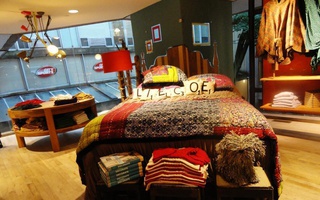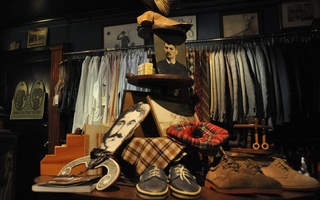It’s also the unique, irreplaceable vintage feel and aesthetic that completes the experience for customers—as well as for Bobby himself. “It’s for both [the customers and me]. I mean, it’s really important to the business because almost everybody that comes in here really loves the shop, you know?” Bobby says. But it’s clear immediately that the design and arrangement of the store isn’t just an advertising strategy—it’s what he loves. “That’s part of the fun for me. Besides the clothing, I like fixtures. If I weren’t doing this, I would probably have been a salvager.”
Bobby’s devotion to design is not as apparent inside the store as outside it—specifically at his warehouse in Lynn, about halfway between Salem and Revere. The warehouse is about twice as big as his regular store and packed with at least twice as much merchandise. But according to him, people can barely believe it’s a warehouse because it looks just like the store. “It’s organized like [the store], all old fixtures, pictures, you know?” he says. Why go to so much effort for a warehouse? “It’s just because if I’m going to be there, I want it to be pleasing to my eye and comfortable, and I want to be able to look at the stuff and enjoy it, not just be here working.”
These are people designing for themselves. In these small, quirky boutiques, the store is not separate from the owner. The store is the product of who the owner is. The successes of their businesses are not due to any brilliant marketing schemes. Patrons get to know the personality of the proprietors through their stores, and the stores are successful because customers come to like the owners as people.
BOXED IN
This group comprises some of the most eclectic stores in Cambridge and Boston, yet among the people who put forth these distinctive visions, Hildebrandt-Hussey is best able to describe design in terms of purposeful aesthetic choices. Perhaps it’s because she is the most classically trained, or perhaps just the existence of an articulated design structure at Anthropologie makes her best able to describe the store’s aesthetic. Boutique store owners, in contrast, are sometimes unable to clearly relate conscious design choices in words.
It’s not for a lack of purpose—it could just be a difficulty in verbally relating their visions. When asked to elaborate, Bobby and Enright seem bound to the wrong medium, perhaps because they are more grounded in physicality. “You can probably explain it better than I can,” Enright says, trailing off from a description of her aesthetic goals. Bobby is not often much clearer. Yet he seems like he’s had more practice than most—he routinely deals with interviewers, designers, and even Hollywood costume designers as they search through his store and warehouse.
At times he speaks indirectly about his role in design and arrangement, and often the way he speaks intimates more than the words he says. “That’s my job, I mean that’s what I live for. That’s what I live to do—is to do this, you know? It’s like, I’m a lucky dude to find this to keep me busy.” At times, it seems the owners are caught in their own boxes, able to physically create and design within the space, but unable to explain what they’ve done to the outside—except by letting others experience it.
That might be the best way to conceive of these stores, if we’re looking through an artistic lens. They are blank canvases to fill, and the canvas defines the piece of art as much as the painter defines the canvas. For Susan L. Corcoran, the founder and owner of Black Ink, it was the space that came to define her store. “It was about functionality, and we were always interested in industrial design and industrial products and parts that we could incorporate in the store,” she says.
Read more in Arts
Music "In Time of War"Recommended Articles
-
Tall, Skim, Decaf... Fiction?If you’ve ever been on an endless hunt for, say, a classic Elizabeth Bowen novel that hasn’t seen shelves since
-
Loeb Fellow Urges Activism in DesignThere is a growing movement in architecture toward social activism, according to design activist and current Loeb Fellow Bryan Bell.
-
TED Curator Speaks at GSD Class DaySpeaking in front of a packed audience in Piper Auditorium at the Harvard Graduate School of Design’s Class Day, Technology Entertainment and Design (TED) Curator Chris Anderson encouraged the graduating class to pursue knowledge and to never stop learning.
-
 Free People Company Spreads Bohemian Vibe
Free People Company Spreads Bohemian Vibe -
 Oona's Experienced Clothing To Launch Online Store
Oona's Experienced Clothing To Launch Online Store -
Student Art Competition Launched for Radcliffe Yard GardenThe Radcliffe Institute for Advanced Study has launched an annual University-wide art competition allowing students to solicit proposals and designs for an installation to be displayed in the garden bordering Brattle Street in the Radcliffe Yard.













